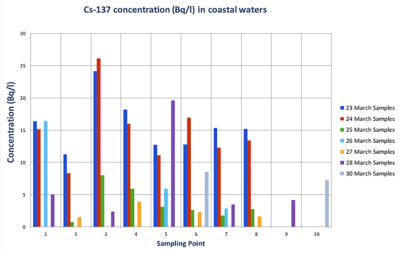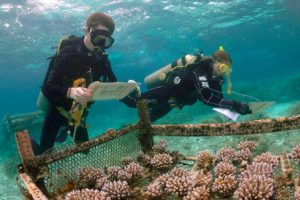Over the past half-century, the world has seen its share of incidents in which radioactive material has been dumped or discharged into the oceans. A British nuclear fuels plant has repeatedly released radioactive waste into the Irish Sea, a French nuclear reprocessing plant has discharged similar waste into the English Channel, and for decades the Soviets dumped large quantities of radioactive material into the Arctic Ocean, Kara Sea, and Barents Sea. That radioactive material included reactors from at least 16 Soviet nuclear-powered submarines and icebreakers, and large amounts of liquid and solid nuclear waste from USSR military bases and weapons plants.
Still, the world has never quite seen an event like the one unfolding now off the coast of eastern Japan, in which thousands of tons of radioactively contaminated water from the damaged Fukushima Daiichi nuclear power plant are pouring directly into the ocean. And though the vastness of the ocean has the capacity to dilute nuclear contamination, signs of spreading radioactive material are being found off Japan, including the discovery of elevated concentrations of radioactive cesium and iodine in small fish several dozen miles south of Fukushima, and high levels of radioactivity in seawater 25 miles offshore.
Concentrations of cesium-137 in seawater 10 to 30 kilometers off the Japanese coast from March 23 to March 30. International Atomic Energy Agency
How this continuing contamination will affect marine life, or humans, is still unclear. But scientists agree that the governments of Japan, the United States, and other nations on the Pacific Rim need to ramp up studies of how far this contamination might spread and in what concentrations.
“Given that the Fukushima nuclear power plant is on the ocean, and with leaks and runoff directly to the ocean, the impacts on the ocean will exceed those of Chernobyl, which was hundreds of miles from any sea,” said Ken Buesseler, senior scientist in marine chemistry at the Woods Hole Oceanographic Institution in Massachusetts. “My biggest concern is the lack of information. We still don’t know the whole range of radioactive compounds that have been released into the ocean, nor do we know their distribution. We have a few data points from the Japanese — all close to the coast — but to understand the full impact, including for fisheries, we need broader surveys and scientific study of the area.”
Buessler and other experts say this much is clear: Both short-lived radioactive elements, such as iodine-131, and longer-lived elements — such as cesium-137, with a half-life of 30 years — can be absorbed by phytoplankton, zooplankton, kelp, and other marine life and then be transmitted up the food chain, to fish, marine mammals, and humans. Other radioactive elements — including plutonium, which has been detected outside the Fukushima plant — also pose a threat to marine life. A key question is how concentrated will the radioactive contamination be. Japanese officials hope that a temporary fishing ban off the northeastern Japanese coast will be enough to avert any danger to human health until the flow of radioactive water into the sea can be stopped.
But that spigot is still running. Since the March 11 earthquake and tsunami, and the resulting damage to the reactors at the Fukushima Daiichi nuclear power plant, huge quantities of water have been poured on four stricken reactors to keep them cool. Thousands of tons of radioactively contaminated water have then been released from the Fukushima complex into the ocean. And even though the Japanese this week stopped a leak of highly radioactive material from the badly damaged Reactor No. 2, the water used to cool the reactor cores continues to flow into the sea. In addition, atmospheric fallout from the damaged reactors is contaminating the ocean as prevailing winds carry radioactivity out over the Pacific.
The Tokyo Electric Power Company (TEPCO) has reported that seawater containing radioactive iodine-131 at 5 million times the legal limit has been detected near the plant. According to the Japanese news service, NHK, a recent sample also contained 1.1 million times the legal level of radioactive cesium-137.
Studies from previous releases of nuclear material in the Irish, Kara and Barents Seas, as well as in the Pacific Ocean, show that such radioactive material does travel with ocean currents, is deposited in marine sediment, and does climb the marine food web. In the Irish Sea — where the British Nuclear Fuels plant at Sellafield in the northwestern United Kingdom released radioactive material over many decades, beginning in the 1950s — studies have found radioactive cesium and plutonium concentrating significantly in seals and porpoises that ate contaminated fish. Other studies have shown that radioactive material from Sellafield and from the nuclear reprocessing plant at Cap de la Hague in France have been transported to the North Atlantic and Arctic Oceans. A study published in 2003 found that a substantial part of the world’s radioactive contamination is in the marine environment.
A sign inside a Hong Kong supermarket assures shoppers that the sushi for sale is not of Japanese origin. Antony Dickson/AFP/Getty Images
But what impact this radioactive contamination has on marine life and humans is still unclear. Even the mass dumping of nuclear material by the Soviets in the Arctic has not been definitively shown to have caused widespread harm to marine life. That may be because containment vessels around some of the dumped reactors are preventing the escape of radiation. A lack of comprehensive studies by the Russians in the areas where nuclear waste was dumped also has hampered understanding. Two events in the early 1990s — a die-off of seals in the Barents Sea and White Sea from blood cancer, and the deaths of millions of starfish, shellfish, seals and porpoises in the White Sea — have been variously attributed by Russian scientists to pollution or nuclear contamination.
How the radioactive materials released from the Fukushima plants will behave in the ocean will depend on their chemical properties and reactivity, explained Ted Poston, a ecotoxicologist with the Pacific Northwest National Laboratory, a U.S. government facility in Richland, Washington. If the radionuclides are in soluble form, they will behave differently than if they are absorbed into particles, said Poston. Soluble iodine, for example, will disperse rather rapidly. But if a radionuclide reacts with other molecules or gets deposited on existing particulates — bits of minerals, for example — they can be suspended in the water or, if larger, may drop to the sea floor.
“If particulates in the water column are very small they will move with the current,” he explained. “If bigger or denser, they can settle in sediment.”
If iodine-131, for example, is taken up by seaweed or plankton, it can be transferred to fish, which are in turn eaten by larger fish, as has been seen in the Irish Sea. Fish can also take in radionuclides in the water through their gills, and radionuclides can be ingested by mollusks. But Edward Lazo, deputy division head for radiation protection at the Organization for Economic Cooperation and Development, said, “This is not a fully developed science and there are lots of uncertainties.”
Radioactive iodine is taken up by the thyroid in humans and marine mammals — or in the case of fish, thyroid tissue — and is also readily absorbed by seaweed and kelp. Cesium acts like potassium and is taken up by muscle. Cesium would tend to stay in solution and can eventually end up in marine sediment where, because of its long half life, it will persist for years. Because marine organisms use potassium they can also take up cesium. “Cesium behaves like potassium, so would end up in all marine life,” said Arjun Makhijani, president of the Institute for Energy and Environmental Research in Maryland. “It certainly will have an effect.”
How the radiation accumulates depends on the degree of exposure and half-life of the element.
Tom Hei, professor of environmental sciences and vice-chairman of radiation oncology at Columbia University, explained that the mechanisms that determine how an animal takes in radiation are the same for fish as they are for humans. Once in the body — whether inhaled or absorbed through gills or other organs — radiation can make its way into the bloodstream, lungs, and bony structures, potentially causing death, cancer, or genetic damage. Larger animals tend to more sensitive to radiation than smaller ones. Yet small fish, mollusks and crustaceans, as well as plankton and phytoplankton, can absorb radiation, said Poston. How the radiation accumulates depends on the degree of exposure — dose and duration — and the half-life of the element, said Hei.
Depending on its chemical form and by what organisms it is taken up, radiation can also concentrate when it moves through the food chain. A 1999 study found that seals and porpoises in the Irish Sea concentrated radioactive cesium by a factor of 300 relative to its concentration in seawater, and a factor of 3 to 4 compared to the fish they ate.
So far, the Japanese government and TEPCO have provided only limited data on marine contamination from the Fukushima plant. Given the emergency situation, independent monitoring along the coast is difficult, said Jan Beránek, director of Greenpeace International’s nuclear energy project. On April 5, the Japanese government set its first standards for allowable levels of radioactive material in seafood. A number of countries have banned seafood imports from Japan. The U.S. has barred food imports from the prefectures closest to Fukushima and the Food and Drug Administration says it is closely monitoring imported food products, including seafood, for radiation contamination.
“This is not an imminent health concern, but we haven’t seen the end of it,” said Theo Theofanous, professor of chemical and mechanical engineering at the University of California, Santa Barbara.
The U.S. National Oceanic and Atmospheric Administration (NOAA) says it is not conducting any monitoring of the marine environment for radiation. The U.S. Environmental Protection Agency (EPA) is monitoring airborne radiation, but its spokespeople were unable to say whether the EPA was monitoring the marine environment as well.
Experts such as Buesseler of Woods Hole, as well as activists like Beránek, said an international effort should quickly be launched to sample and measure radionuclides in the ocean, seafloor, and marine life, with close attention paid to which direction ocean currents can be expected to transport water potentially contaminated by Fukushima.




